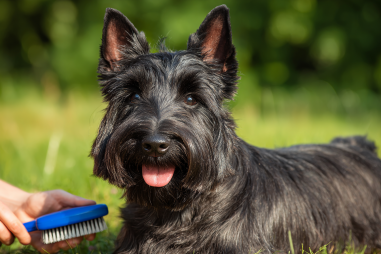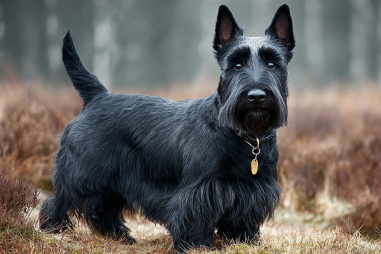Bringing a new dog into your home is always an exciting time, especially when you have your heart set on a specific breed like the Scottish Terrier. However, if allergies are a concern for you or your family members, it’s essential to understand how this charming little breed might affect your health and comfort. Scottish Terriers have a distinctive look and personality, but what about their impact on allergies? This article will walk you through everything you need to know about Scottish Terrier allergy information to make an informed decision and create a comfortable living environment for all.
Are Scottish Terriers Hypoallergenic?
When people ask if Scottish Terriers are hypoallergenic, the simple answer is that no dog breed is entirely hypoallergenic. However, some breeds are better suited for allergy sufferers because they produce fewer allergens or shed less dander. The Scottish Terrier tends to be a better option for some allergy sufferers because they have a wiry double coat that does not shed heavily. Their fur is dense and requires regular grooming, which helps trap dander and loose hair, minimizing airborne allergens.
It’s important to note that allergens primarily come not from the dog’s hair but from proteins found in their dander (dead skin cells), saliva, and urine. If you are allergic to dogs, you might react to the Scottish Terrier’s dander, but their minimal shedding can reduce the spread of these allergens around your home.
Shedding and Dander Characteristics
Scottish Terriers are known for their wiry, weather-resistant coats which are different from the soft, fluffy coats seen in many other breeds. Their coat consists of a harsh topcoat and a softer undercoat, and because of this texture, Scotties shed very little compared to other dogs. The minimal shedding means fewer loose hairs covered in dander floating around your living space. However, they do still produce dander, and since this is the primary allergen for dog-sensitive individuals, it’s important to manage exposure carefully.
Some Scottish Terrier owners report that their dogs cause minimal allergy symptoms compared to other breeds they have encountered, largely due to this shedding profile. But again, individual sensitivity varies, so this breed might still trigger reactions in highly allergic individuals.
Managing Allergies Around Scottish Terriers
If you love the Scottish Terrier but live with allergies, several strategies can help you reduce allergic reactions and enjoy your pet’s companionship more comfortably:
- Create dog-free zones: Designate certain areas of your home, such as bedrooms, where the dog isn’t allowed. This helps keep allergens contained and provides a safe space for allergy sufferers.
- Use air purifiers: HEPA air purifiers can trap pet dander and other airborne allergens, significantly improving indoor air quality.
- Vacuum frequently: Use a vacuum cleaner with a HEPA filter to regularly clean carpets, rugs, and upholstery to remove dander and hair.
- Wash bedding often: Both your bedding and your dog’s bedding should be washed regularly to minimize allergen buildup.
Grooming to Reduce Allergens
Regular grooming is vital for Scottish Terriers—not only to keep their coat healthy and looking its best but also to manage allergens. Since Scotties do not shed much naturally, grooming helps remove loose hair and dead skin cells before they become airborne allergens.
- Frequent brushing: Brushing your Scottie’s coat several times a week helps remove dander and loose hair. Using a slicker brush or comb designed for wiry coats can be especially effective.
- Professional grooming: Scottish Terriers require periodic hand-stripping or clipping by a professional groomer. This process removes dead hair and keeps the coat healthy, which can also reduce allergen levels.
- Bathing: Bathing your Scottish Terrier every few weeks with a dog-safe shampoo can reduce dander buildup. Be careful not to bathe too often, as overbathing can dry out the skin and exacerbate scaling.
After grooming, it’s also helpful to wash your hands thoroughly to prevent transferring allergens to your face or other surfaces.
Tips for Allergic Dog Owners
Living with a dog when you suffer from allergies requires awareness and some lifestyle adjustments. If you’re considering a Scottish Terrier and worry about allergic reactions, keep these tips in mind:
- Spend time around the breed first: Before bringing a Scottish Terrier home, try spending time with Scotties in friend’s homes, dog shows, or shelters to see how your allergies react.
- Clean and groom often: Dedicate yourself to a regular cleaning and grooming schedule to maintain a low allergen environment.
- Consider allergy medications: If recommended by your doctor, over-the-counter or prescription allergy medications can help control symptoms and improve comfort.
- Keep your dog healthy: A healthy dog produces fewer allergens; ensure your Scottie receives proper nutrition and veterinary care.
- Use hypoallergenic bedding and covers: Protect furniture with washable, allergy-friendly covers to trap dander and make cleaning easier.
When to Consider Allergy Testing
If you or your family members are unsure about the severity of your allergies related to Scottish Terriers or dogs in general, allergy testing can provide valuable insight. An allergist can perform skin or blood tests to identify specific sensitivities, which helps determine if having a Scottish Terrier is advisable.
Allergy testing is particularly useful if:
- You’ve noticed symptoms like sneezing, itching, or watery eyes around dogs.
- You want to confirm whether your symptoms are truly due to pet dander before making a commitment.
- You need personalized recommendations for managing pet allergies.
In some cases, allergists may also suggest immunotherapy (allergy shots) that can gradually reduce sensitivity to allergens over time, making living with a pet more comfortable.
Living Comfortably with a Scottie
Choosing a Scottish Terrier as a companion when allergies are a concern is a decision that comes with some precautions, but many allergy sufferers find ways to live happily with their Scotties. The breed’s minimal shedding and dense coat can make a significant difference in reducing airborne allergens compared to other dogs. With consistent grooming, cleaning, and allergy management strategies, you can create a welcoming and healthy home for both you and your furry friend.
Remember that every individual’s allergic response is unique, so spending time with the breed beforehand and consulting with medical professionals will set you up for success. Scottish Terriers bring a lively spirit, loyalty, and charm into the home—all qualities worth considering alongside allergy concerns. With preparation and care, a Scottish Terrier can become a beloved and manageable member of your family.







